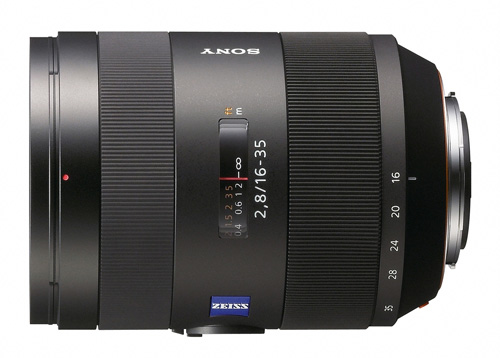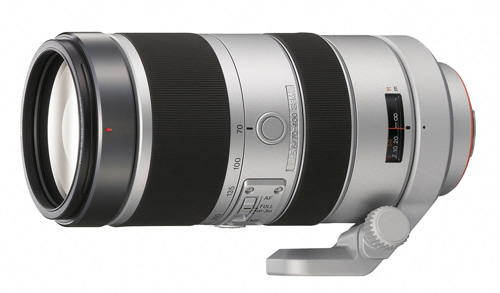Sony A900 Full-Frame: Hands-On Preview
by Wesley Fink on September 12, 2008 12:00 AM EST- Posted in
- Digital Camera
New Zeiss 16-35mm f/2.8 and 70-400mm f/4-5.6 G Lenses
SAN DIEGO, Sept. 9, 2008 - Sony is expanding its number of high performance Carl Zeiss and G Series lenses with the addition of the new SAL1635ZA and SAL70400G models.
Vario Sonnar T* 16-35mm f/2.8 ZA Carl Zeiss Series Lens

The SAL1635ZA model is a super wide-angle 16-35mm f/2.8 constant aperture zoom lens, well suited for landscape, snapshot, and indoor photography. It is constructed of 17 lens elements in 13 groups, including an extra-low dispersion (ED) for exceptional clarity and center-to-edge resolution and a super ED glass element for much stronger correction of chromatic aberration or discoloration. It also features three aspherical lens elements that provide greater brightness from center to the edge of the image field. Its Carl Zeiss T* (T star) coating technology provides higher light transmission, and minimizes flare to produce images of luminous clarity, color and sharpness.
The SAL1635ZA lens offers the utmost flexibility in challenging lighting conditions due to its wide f/2.8 constant aperture. Combined with Sony's in-camera SteadyShot Inside image stabilization system, this lens is the only large aperture, full-frame capable, wide-angle zoom lens with the benefit of stabilization in the industry. Smooth, fast, and precise focusing is delivered by Sony's Super Sonic wave Motor (SSM) autofocus drive system. It utilizes a solid-state focus drive motor to provide silent, high-speed response, powerful torque, and fine rotational control - critically important for large wide-aperture lenses.
70-400mm f/4-5.6 G Series Lens

The SAL70400G lens is a 5.7x super telephoto zoom lens and the latest addition to Sony's G-series line of premium lenses. Designed to deliver extremely sharp descriptive performance across its wide focal length range, it is ideally suited for sports, action, and wildlife photography. Constructed of 18 elements in 12 groups, it includes two extra-low dispersion glass lenses for high contrast, sharp details, and exceptional center-to-edge resolution with minimal chromatic aberration. A circular aperture with nine diaphragm blades is utilized to achieve natural, aesthetically pleasing de-focusing effects.
With a minimum focus distance of 1.5m and maximum magnification of 0.27x, the lens delivers best-in-class performance. Like the SAL1635ZA lens, focus drive is provided by its SSM system, which offers the speed and rotational precision often required for telephoto shooting. Additionally, the lens has an internal focusing system for faster autofocusing.
A focus-mode/range switch and three focus-hold buttons have been added to the lens barrel for enhanced operability. For both models, when attached to the flagship α900 camera body, the AF hold buttons can be customized to activate the intelligent preview function.
Price and Availability
The Vario-Sonnar T* 16-35mm f/2.8 ZA and 70-400mm f/4-5.6 G lens will ship in January 2009 for about $1,800 and $1,500, respectively.










53 Comments
View All Comments
Wesley Fink - Friday, September 12, 2008 - link
That is the EN-EL4(a) battery for the Nikon Pro cameras and the Sony capacity is specified as 1650mAh and not 16500. We do need an edit function here!dr4gon - Friday, September 12, 2008 - link
The memory stick is so that you have the ability to shoot RAW+JPG. It's just for redundancy in case your compact flash card dies for whatever reason. All is not lost since the JPEGs can be saved on the MS like the a700.VirtualMirage - Friday, September 12, 2008 - link
On the a700 you can only shoot to one memory card or the other at any given time. When set to RAW+JPEG, it doesn't send one file to one card and the other file to the other card (that option is not even available). It would be neat if it did, though, since I could have used that feature with my a700 when doing a wedding shoot back in June. The camera also doesn't automatically switch over to the other card when the first card is full, you have to go into the menu and switch it over manually. The a900, from reading a preview on another site, does the exact same thing in regards to memory card management as the a700 (which is a bit of a shame).As for the use of a memory stick and CF, I can understand the con with this since if you want to have a fall back memory card you have to deal with two different memory card formats. But the advantage to it, though, is a smaller camera profile since two CF card slots would require a little more room.
Below are some features I wish my a700 did (as well as the new a900) in regards to its two memory card slots:
-Automatic switchover when the first card is full.
-Option to have RAW files go to one card and a JPEG version go to the other card.
-Backup mode where ever picture shot is copied (in the same file format) to both cards.
Shame they don't do this. But oh well, the a700 is still a great camera. And with the new firmware that got leaked out earlier this week (v.4), it's an even better camera since they added some features to the a700 that are in the a900. Some of these improvements are: High ISO NR can now be turned off (used to be you can go no further than LOW), Image quality algorithms have been improved with NR on and off (finer grain pattern in high ISO shots, no more watercolor NR), EV bracketing now has a +/- 2 option for HDR shooting, and some people are reporting WB has improved in certain lighting. Their maybe more improvements, but since it was leaked with no update readme (and was quickly removed from the site too when it was discovered), the only improvements mentioned are what people have found after installing it. Supposedly, the official release of the firmware update is sometime next week (the 16th is what I am hearing). Probably so as to not steal the a900's thunder.
~Paul